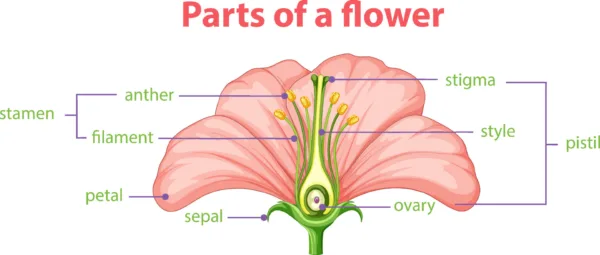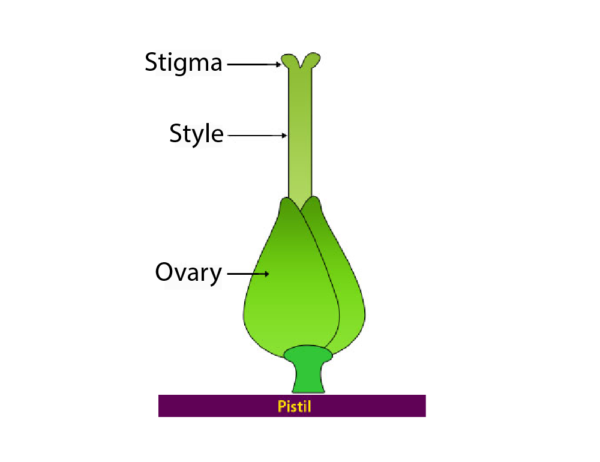A flower is a visually appealing, vibrant, and fragrant shoot dedicated to sexual reproduction in angiosperms. Flowers consist of four organ sets: Calyx, Corolla, Androecium, and Gynoecium. These captivating Parts of a Flower attract pollinators and serve as a source of nectar.
Parts of Flower
Flowers, created by nature, are essential for plant reproduction. A flower comprises various parts, each serving a specific function. Sepals protect, petals attract, stamens are male, and pistils are female. Let’s explore the main parts of a flower in detail:

1. Sepals:
- The sepals form the outermost whorl of a flower and are usually green in color. Collectively known as the calyx, sepals act as protective covers for the developing flower bud before it blossoms.
- These modified leaves shield the delicate inner parts from external damage and provide structural support to the flower.
Function of Calyx
The calyx, the outermost whorl of a flower, has multiple functions.
- It protects the developing flower bud from external damage and harsh weather conditions.
- The sepals of the calyx provide structural support, maintaining the flower’s shape and position.
- In some flowers, the sepals tightly enclose the petals and reproductive organs, protecting them until the flower is ready for pollination.
- Sepals, although typically green, can contribute to the flower’s attractiveness through bright colors or interesting shapes.
- The calyx plays a crucial role in attracting specific pollinators to the flower.
2. Petals:
- The colorful and often fragrant petals lie just above the sepals and form the corolla of the flower.
- Their vibrant hues and enticing scents attract pollinators such as bees, butterflies, and birds. Acting as advertisements, petals entice these pollinators to come closer, facilitating the transfer of pollen from one flower to another, thus promoting pollination.
Functions of Corolla
The corolla, as the second whorl of a flower, performs essential functions:
- The corolla protects the flower’s reproductive organs from external damage.
- The colorful and fragrant petals of the corolla attract pollinators.
- The shape and arrangement of the corolla’s petals guide pollinators towards the reproductive structures of the flower.
- Some corollas have specific patterns or markings that act as nectar guides, directing pollinators to nectar-producing glands.
- The corolla helps reduce water loss from the reproductive organs, particularly in arid or windy environments.
3. Stamens:
Stamens are the male reproductive organs of a flower and comprise the androecium. Each stamen typically consists of two parts:
Anther:
- The anther is a yellowish sac-like structure located at the top of the stamen.
- This is where pollen grains are produced and stored.
Filament:
- The filament is a slender stalk that holds up the anther, ensuring it remains in an elevated position for better pollen dispersal.

Functions of Androecium
The anther (androecium) releases pollen grains, which are essential for fertilization. When pollinators come into contact with the anther, pollen sticks to their bodies and may be carried to the female parts of the same or another flower, initiating fertilization.
4. Pistil:
The pistil is the female reproductive organ of the flower and forms the gynoecium. It is usually located at the center of the flower and comprises three parts:
Stigma:
- The stigma is the topmost part of the pistil and is often sticky or feathery.
- Its role is to receive pollen during the process of pollination.
Style:
- The style is a tube-like structure that connects the stigma to the ovary.
- It provides a pathway for the pollen tube to grow and reach the ovules.
Ovary:
- The ovary is the swollen base of the pistil and houses one or more ovules.
- After successful fertilization, the ovary develops into a fruit, enclosing the seeds.

Functions of Gynoecium
The pistil (gynoecium) plays a crucial role in fertilization, as the pollen grain needs to reach the stigma, where it can germinate and form a pollen tube for the transfer of male gametes to the ovules inside the ovary.
5. Receptacle:
- The receptacle is the base of the flower, to which all the other flower parts are attached.
- It supports and holds the flower together, providing the structure for the arrangement of sepals, petals, stamens, and pistil.
6. Nectaries:
- Some flowers have nectaries, specialized glands that produce nectar.
- Nectar serves as a reward for pollinators, providing them with a nutritious food source while they visit the flower for pollen transfer. The sweet taste of nectar attracts pollinators, increasing the likelihood of successful pollination and fertilization.
Complete vs Incomplete Flower
1. Complete Flower:
- A complete flower possesses all four whorls: sepals, petals, stamens, and carpels.
- Examples include roses, lilies, and sunflowers, with each whorl contributing to the reproductive process.
2. Incomplete Flower:
- An incomplete flower lacks one or more of the four main whorls.
- Examples include grasses and corn, which may lack petals, stamens, or carpels.
Differences between Complete Flower and Incomplete Flower
| Aspect | Complete Flower | Incomplete Flower |
| Whorls Present | Contains all four whorls: sepals, petals, stamens, and carpels. | Lacks one or more of the four whorls. |
| Reproductive Organs | Has both male (stamens) and female (carpels) reproductive organs. | May have only male stamens or only female carpels, not both. |
| Petals | Typically, complete flowers have petals. | Incomplete flowers may lack petals. |
| Examples | Roses, lilies, sunflowers, etc. | Grasses, corn, willows, etc. |
| Reproductive Purpose | Can undergo sexual reproduction due to the presence of both male and female organs. | May still participate in sexual reproduction, but some may rely on other methods like wind pollination. |
Uses of Flowers
- Decoration: Flowers decorate and enhance the beauty of homes, offices, events, and weddings.
- Gift-giving: Flowers serve as popular gifts for birthdays, anniversaries, and special occasions, expressing emotions and conveying messages.
- Symbolism: They symbolize various emotions and messages, representing love, appreciation, and condolences.
- Aromatherapy: Fragrant flowers are used in aromatherapy to promote relaxation, reduce stress, and enhance mood.
- Culinary uses: Certain flowers are edible and add flavor and visual appeal to culinary creations.
- Medicinal purposes: Many flowers possess medicinal properties and are used in traditional and alternative medicine.
- Pollination: They attract pollinators, such as bees and butterflies, playing a crucial role in plant reproduction.
- Wildlife habitat: They provide food and shelter for various animals and insects, contributing to biodiversity.
- Environmental benefits: They improve air quality, reduce soil erosion, and support ecosystems.
- Cultural and religious significance: Flowers hold cultural and religious significance, being used in rituals and ceremonies to symbolize purity and spirituality.
References
- “The Parts of a Flower and Their Functions.” DK Find Out, Dorling Kindersley Limited, 2021.
- “Parts of a Flower and Their Functions.” Greentumble, 23 June 2020.
- “Flower Anatomy.” Encyclopedia Britannica, 15 March 2021.
- “Parts of a Flower and Their Functions.” Science Learning Hub, University of Waikato.
- “The Structure and Functions of Flowers.” ScienceDirect, Elsevier B.V., 2022, .
Learn more